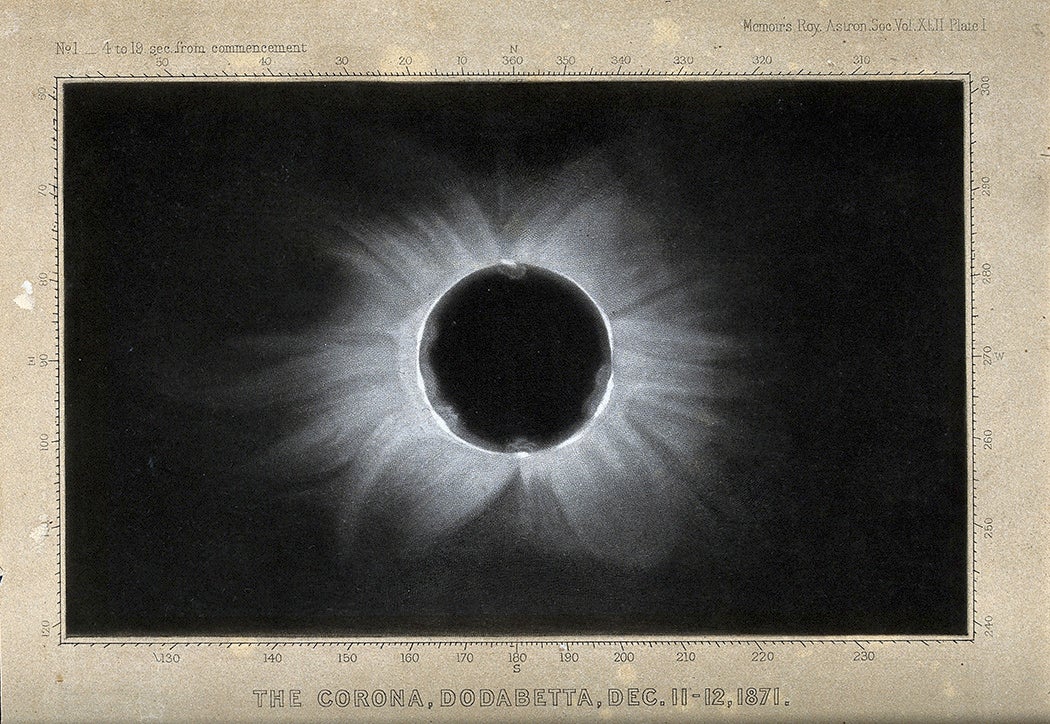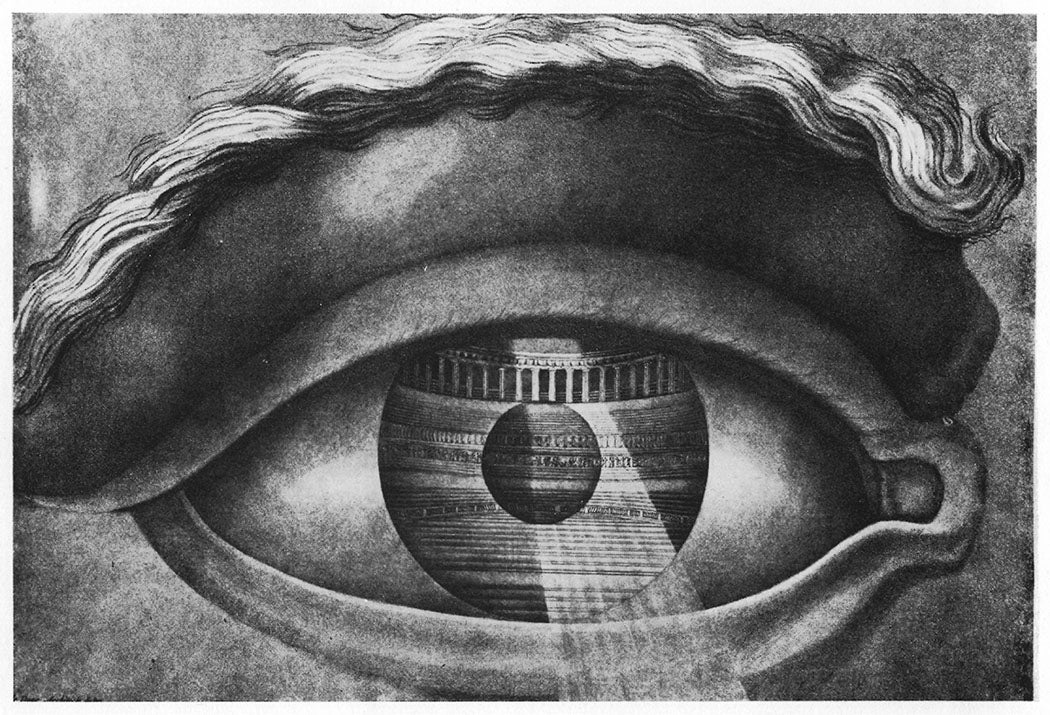As a student, I wondered why the eighth century monk Fridugisus of Tours read the Bible to prove the existence of shadows when he could see shadows on the page. In his letter to Charlemagne, “On the Being of Nothing and Shadows,” Fridugisus deduces shadows from Genesis 1:2: “And the shadows were over the face of the deep.” To demonstrate that shadows move, he turns to Psalms 105:28: “He sent shadows.” Fridugisus thinks this better evidence than the shadow he sent by turning the page.
Audio brought to you by curio.io
As a professor, I find myself in the same position as Fridugisus. I do not trust my eyes! Instead of reading between the lines of divine testimony, I read between the lines of scientific testimony. I ask: Do astronomers presuppose the existence of shadows when they calculate the altitude of lunar mountains? Do physicists imply that shadows move when they measure waves in a “shadow tank”? (The tank is filled with transparent water!)

Shadows were fringe phenomena in the Dark Ages. They are rarely depicted in the era’s paintings. Perhaps the artists portrayed only what they believed to be visible. In De Anima, Aristotle writes that each sense has its own proper object: “Sight has color, hearing sound, taste flavor.” Color requires light. No light, no sight. That is why we cannot see in the dark!
The negative metaphysician takes exception: In a blackout, you do not hear the darkness or taste the darkness. You see the darkness. It even looks a certain way: dark all over, not red all over. You must inform a blind companion of the darkness. For a blind people cannot see the darkness. It no more looks dark to them than it looks dark behind your head. To see the darkness behind your head, you must turn around.
A second exception requires turning the lights back on. The black letters on a page are seen by virtue of the light they absorb, not the light they reflect. The less light escaping from letters, the better letters are seen. Color scientists have amended the canonical phrase, “To see is to see light,” for light absorbers. They now say black is the color of indiscriminate light absorbers. Whereas other colors are associated with light (of an unabsorbed wavelength), black is the appropriate visual response to the absence of light.

A third exception to “To see is to see light” exists for silhouettes. During a total solar eclipse, you do not see the moon by virtue of the light its front reflects. Nor by light the front side absorbs. For the front side is completely enveloped by the shadow cast by the back side of the moon. Thanks to tidal forces, one side of the moon permanently faces earth. For centuries, bards yearned to see the opposite side:
O moon, when I gaze on thy beautiful face,
Careering along through the boundaries of space,
The thought has often come into my mind
If I ever shall see thy glorious behind.
Edmund Gosse attributed this quatrain to his housekeeper. The negative metaphysician thinks the poetess overgeneralized from front-lit viewing. She thinks that if she witnessed a solar eclipse, she saw the lunar rear. For that is the only part of the moon causing a difference in what she is seeing.
Shadows force the fourth and most profound exception to “To see is to see light.” Shadows cannot absorb light. Any light present in a shadow is pollution. For a shadow is an absence of light. Absences of light cannot block light. Metaphysicians who think reality is always positive deny the visibility of shadows. We see only light, they say. A shadow is a hole in the light, not a part of what is seen, they say.
* * *
A positive metaphysician translates talk of negative things into talk about positive things. The methodology harmonizes with the lyrics of Johnny Mercer’s 1944 hit song “Accentuate the Positive” (adapted from a sermon by Father Divine):
…Jonah in the whale, Noah in the ark
What did they do
Just when everything looked so dark
Man, they said we better, accentuate the positive
Eliminate the negative
Latch on to the affirmative
Don’t mess with Mister In-Between
Only causes exist. And all causes are positive things that can transfer energy. Milk in a straw is not pulled up by a vacuum. The milk is pushed up by the atmosphere pressing down more strongly on the surrounding surface of the liquid.
Weekly Newsletter
The height of a tower and the angle of the sun explain the length of its shadow. But the length of the shadow and the angle of the sun do not explain the height of the tower. For the shadow does not cause the tower’s height or the sun’s position. “Shadow” can be mentioned in a causal explanation only in the way “not” is mentioned—as abbreviating something positive. Not getting 6-6 on a roll of a two dice is just a short substitute for a long disjunction of thirty-five positive alternatives: getting 1-1 or 1-2 or 1-3 or etc. “Shadow” footnotes what is not illuminated—or what is in the background.
“Nay!” says Eye. Shadows stand out as figures. “Exist” derives from “ex” (out) and “sistere” (made to stand). Eye conclude shadows exist.

If shadows were not seen as figures, shadow plays would be as visually inert as radio plays. Shadows are enlivened by actions, such as jumping, bowing, and kissing. This animation raised medieval concern about idolatry. To appease the pious, puppets were perforated. The dots of light were reminders that shadows are lifeless effects of positive causes.
Positive metaphysicians concede that the shadows are “seen” as figures rather than ground. That is what makes shadows exemplars of illusion! In Plato’s famous Allegory of the Cave, the audience is born into a shadow play. The cave men are hoaxed into believing that these copies are originals. Everything the poor devils “see” is counterfeit.
As a playwright, Plato noticed that the visual illusion is widened to the ear. Sounds are attributed to what the eye nominates as the source. Once the shadow’s lips move, a voice from the rear switches to the shadow.
If a positive metaphysician is willing to “mess with Mister In-Between,” he could identify shadows with unilluminated places. Places must exist because movement is a translation from one place to another place.
Places cannot themselves move. Perhaps the immobility of shadows is a correct consequence of shadows being unilluminated places. Consider the shadow of a spinning ball: ❍. Does the shadow also spin? In the absence of visible movement, the eye answers “N❍!” But if the shadow cannot rotate, then how is it capable of translational motion across a surface? Each stage of the shadow depends on the ball and light source, not the previous stage of the shadow. This explains why the shadow is never dented by collisions. What appears to be a single shadow traveling along the surface is a sequence of stationary shadows. The appearance of succession is a succession of appearances.
* * *
The optics of the Chinese Mohists focused on shadows rather than light. They defend the literal truth of Chuang Tzu’s aphorism, “The shadow of a flying bird never moves.” For shadows “last” only an instant. The Chinese dialectician Kung-sun Lung (ca. 325–250 BCE) appears to have extended the objection to the bird. At each moment, the bird is where it is, and so is not traveling. Since the bird is always at rest, the bird no more moves than its shadow.
Calculus teachers try to solve the paradox with the “at-at” theory of motion. Motion is nothing more than being at one place and then at another place. Since motion is a rate of change in location, the flying bird has a non-zero velocity at each instant—as does the bird’s shadow.
Medieval metaphysicians would insist that the bird’s motion differs from its shadow “motion” because one stage of the bird causes its subsequent stages. Shadows lack this immanent causation. Their stages are externally controlled by the light source and the object blocking light. Since Scripture commits to shadow movement, Fridugisus argues that shadows must be substantial enough to persist through space, perhaps like a diver’s lungful of air. “All Scripture is breathed out by God and profitable for teaching, for reproof, for correction, and for training in righteousness” (2 Timothy 3:16).
From the Genesis prologue to God breathing life into Adam, we further know that everything was created from nothing. Since each thing comes from nothing, shadows are exemplars of this original clay. When the shadow of a tower grows longer in the afternoon, more shadow is added (as opposed to more light being subtracted).
As substances, shadows have the same existential inertia as their casters. Both are wholly present through time. Is this to deny that shadows are nothing? Just the opposite! Fridugisus is saying that the stuff composing shadows, nothingness, has a different nature than commonly assumed. Fridugisus foreshadows contemporary physicists who characterize nothingness as vacuum energy. Aristotle conceives the vacuum as a total absence. Aristotle deduces many absurdities from this extreme conception. Big Bang cosmologists counter that the vacuum teems with virtual particles. Thanks to the interconvertibility of energy and mass, a universe with no mass could spontaneously produce particles from the ambient energy.
Fridugisus’ brother monks might have complained that they could not get a grip on substantial nothingness. Shadows are available only to the eye. To demonstrate that shadows are tangible, Fridugisus turns to Exodus 10:21: “And the Lord said unto Moses, Stretch out thine hand toward heaven, that there may be darkness over the land of Egypt, even darkness which may be felt.”
This passage may seem like nonsense to those who experience darkness as the absence of occlusion: “The limitlessness of the visual field is clearest when we are seeing nothing in complete darkness” (Ludwig Wittgenstein, Zettel 616). But I suspect Fridugisus experienced darkness, like me, as a kind of maximally occluding black smoke. The smoke is so thick that I cannot see my hand in front of my face!
Curiously, if I wave my hand, I do have the visual impression of seeing my hand move. When my wife waves her hand in front of my face, I cannot see it. What is special about my hand?
“Synesthesia,” answers one team of neuro-scientists. No one’s visual system is perfectly insulated from the other senses. Sight affects sound (as with the ventriloquism effect of talking shadows). And kinesthesia (sense of bodily position) affects sight. Strong synesthetes have more sensory “leakage” and visualize their moving hand more vividly than I do. They find “thick shadow” less oxymoronic than those with more completely insulated perceptual channels. Synesthetes are surprised that “bright sound” and “sweet perfume” are metaphors. Some developmental psychologists conjecture that we are born at the summit of synesthesia, with all perception confusedly unified, and then segregate in downward steps (often concluding that there are five senses, which strikes many perceptual psychologists as undercounting). Adult synesthetes are lingerers, not climbers.
Many people feel it is darkest before the dawn. But they are mis-perceiving the night’s most extreme absence of heat (cold) as the most extreme absence of light (dark). The night is darkest at midnight, meaning midway between sunset and sunrise. The night is coldest at dawn. For that is when the warming sun has been absent longest.
Perception of what is and of what is not, is interpretative. This vindicates Fridugisus’ resistance to treating his observations as the last word. But observations are, to a greater extent than his piety permitted, the first word.
Support JSTOR Daily! Join our new membership program on Patreon today.







